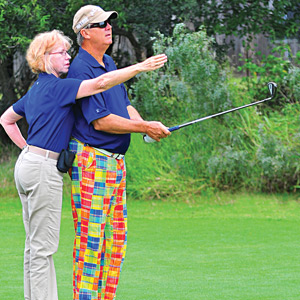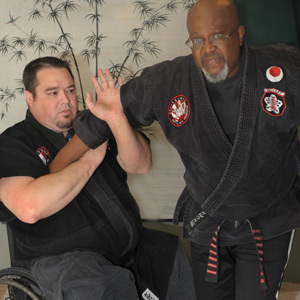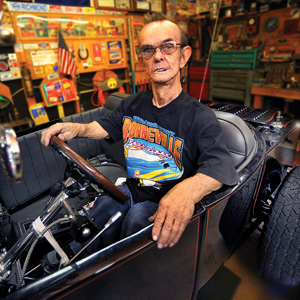 While the personal pursuit of excellence can certainly be daunting for the majority of us blessed with bodily health and totality, for those physically challenged because of disabling illness, injury or genetics, the range of potential accomplishment must be severely restricted – or is it? Mankind’s history is rife with myriad examples of those who refused to let physical adversity place undesired limits on their lives or the attainment of their goals. What follows are three stirring examples, each highlighting incredible and inspirational determination and achievement, where a very special trio of San Antonio men, despite severe limitations, seemingly “do the impossible” with an enviable amount of naturalness, grace and humility.
While the personal pursuit of excellence can certainly be daunting for the majority of us blessed with bodily health and totality, for those physically challenged because of disabling illness, injury or genetics, the range of potential accomplishment must be severely restricted – or is it? Mankind’s history is rife with myriad examples of those who refused to let physical adversity place undesired limits on their lives or the attainment of their goals. What follows are three stirring examples, each highlighting incredible and inspirational determination and achievement, where a very special trio of San Antonio men, despite severe limitations, seemingly “do the impossible” with an enviable amount of naturalness, grace and humility.
Bruce Hooper
Blind champion golfer
After blindness unexpectedly entered Bruce Hooper’s life in 1998 and turned his world upside down, what the future would hold for the high-achieving salesman was, admittedly, an uncomfortable unknown. At the time, Hooper was a respected traveling representative for the prestigious Spalding Sports Worldwide, promoting golf equipment and successfully servicing retail outlets as well as private and public courses. Aside from his natural gift for salesmanship, his product line perfectly reflected his past familiarity with the game of golf. His father played and encouraged his son, who eventually excelled at the sport, especially during his high school years at Alamo Heights.
In 1962, the teenager took first place in the highly competitive San Antonio City Junior Championship. And in 1963 and 1964, he comprised part of the four-man team that won “state” for his beloved campus. By age 18, Hooper boasted a plus-2 handicap (that’s two better than a zero handicap) and was even offered a scholarship to Texas A & M. Then, for personal reasons, the young man decided to pursue other interests and, basically, quit playing serious golf.
However, with so much natural ability and acquired knowledge of the game, it wasn’t surprising that by the early 1970s, Hooper was once again involved with golf — this time as a teacher, club repairman and golf course manager. As he admits, “I wasn’t driven by a passion. Golf was just something I understood.” It was during this time that Spalding discovered their future “star” salesman, signing on the 32-year-old in 1978 and heralding a career that would span 25 productive years ending only — and with reluctance — when his sight deteriorated.
It was on a sales call when Hooper noticed something was wrong with his vision. As he recalls of that pivotal day, “I remember heading to my meeting and looking up at a street sign, and all of a sudden I couldn’t read the sign.” After a friend drove him home, he went to an ophthalmologist and received the news that his right eye’s central vision was gone and the left eye’s was soon to be gone. He was diagnosed with a form of macular degeneration, an incurable eye disease where the center of the retina degenerates. As the illness ran its course, he was left with a small amount of peripheral vision, but over subsequent years, that has worsened as well.
Eventually unable to work as an outside salesman, he was fortunate to have had disability insurance that continued to provide financial security, but the otherwise healthy 52-year-old was forced to abandon his career.
After an idle year, a surprised but skeptical Hooper was invited by a close friend to go “play a round of golf.” While reluctant, he accepted. He knew the fundamentals wouldn’t be a problem, but he would have to totally rely on his buddy for direction, yardages, wind factors and other key information. Although not a great initial 18 holes, the game proved to be fun and soon led to other outings.
Enter the world of blind golf. As Hooper grew more comfortable with the sightless version of the game, he became intrigued when he discovered that there were others playing with the same limitations he possessed — in fact, playing competitively in sanctioned tournaments. Eager to pit his skills against others equally challenged, he entered his first official “blind” tournament in 2002 in Dallas, where (with his capable wife now acting as indispensable coach, caddy and counselor) he finished in second! Since then he and his wife, Judy, have gone on to win seven U.S. National Championships, three Canadian Open championships, a World Blind Golf Championship held in Tokyo, and in June of this year the McCulloch Memorial Cup Blind Match Play Championship in Rittman, Ohio.
As further proof of his golfing prowess beyond the blind-only competitions, in 2010, 11-handicapped Hooper (and Coach Judy) even bested some very serious sighted players by winning the consolation round of the San Antonio City Senior Match Play Championship — wow!
When not honing his skills on the links, he and Judy proudly serve as board members for San Antonio’s Lighthouse for the Blind. He is also a co-founder of chron.com, “American Blind Golf, a nonprofit organization dedicated to the sport, and serves on the PGA of America’s Disabled Golf Committee. So, while obviously wishing he was still sighted, the now 66-year-old Hooper freely admits that blindness, coupled with golf, has surprisingly allowed him to experience, achieve and contribute in ways he never would have before, and “that’s been a joyful eye-opener.” Fore!
Craig Phinney
Paraplegic martial arts expert

For Craig Phinney, disability arrived suddenly in June 1978, when the active 7-year-old was unexpectedly diagnosed with a serious circulation defect. After additional medical tests, it was determined that open-heart surgery would be required. During the delicate procedure, it was discovered his condition was much worse than anticipated, and although the initial circulatory problems were eventually corrected, complications resulted that left the youngster paralyzed from the waist down. After a month’s stay in the hospital, once he was back home, the reality and permanence of his paralysis hit. As he remembers, “I realized I’d never be able to ride my bike again or run as I used to.”
For a disabled youth in the 1980s, life wasn’t entirely mainstream. Special accommodations were required at school that resulted in a degree of separation from the other “normal” children in his classes. Despite his being perceived as different by most of his classmates, while in seventh grade he met the boy who would become his No. 1 buddy, Joe Goodridge. Recalling that relationship (which is still strong today), Phinney relates, “He was the first on campus who accepted me as a person, not just a kid in a wheelchair.” Aside from the unqualified friendship, Joe was also able to give him his introduction to martial arts.
Fired by the popular Kung Fu movies of the time, Phinney was entranced with the idea of learning these combative techniques. And when he found out that his new best friend was enrolled in the Japanese-style aikido classes, he resolved to sign up as well. Unfortunately, when he tried joining these classes, he was denied. Not to be deterred from his dream, however, with the help of Joe and his black-belt-qualified father, Lee, the determined young man began studying privately and successfully at the Goodridges’ house.
During his college years at Texas Tech University, Phinney, thanks primarily to a pair of willing and open-minded instructors, was allowed to take additional karate/aikido classes as electives. It was there that he continued to learn and grow in this more formal environment, where despite his inability to jump and kick, imaginative adaptations were developed, honed and practiced.
After a fruitful year of study, however, the unthinkable happened. The head of the United States Aikido Federation visited the university, and upon learning of the school’s “special” student, ruled that an individual confined to a wheelchair could not be allowed to continue training or test for the progression of belts. As Phinney relates of that difficult time, “I was crushed and feared my paralysis would always be an obstacle for official recognition within the martial arts world.”
Filled with deep regret, the energetic Phinney immersed himself in any other sport in which he would be allowed to participate. What followed was wheelchair basketball, football, even water and snow skiing. His love of martial arts never diminished, however, and thanks to his old friends, the Goodridges, he was eventually able to return to and exceed within the demanding, physical world of personal defense.
Returning to San Antonio in 1998 and quickly reconnecting with his old pal Joe, he was informed that Joe’s father (now a seventh-degree black belt holder) had opened his own martial arts school and would enjoy having his son’s friend join. Reluctant after his Aikido experience, Phinney was eventually reassured by Goodridge, who explained that his training was offered under the auspices of the respected Zujitsu Federation headed by the forward-thinking Soke Chaka Zulu, and, frankly, he didn’t “foresee any testing issues.” This prediction proved true because, upon meeting Zulu six months into the training, Phinney was not only welcomed but applauded for his real accomplishments, dedication and achievement. Remembering that heady time, he offers, “It was both exhilarating and challenging because this was the first time traditional Japanese martial arts were adapted and sanctioned for someone in a wheelchair, and I was the guy it was done for.”
In 2008, tested against able-bodied opponents, a 38-year-old Phinney earned his black belt in jujitsu — a difficult achievement for anybody. At the presentation was a proud but not surprised Soke Chaka Zulu, who flew in from the Virgin Islands to attend. Then, in 2011, Phinney was presented with his second-degree black belt and also started to train in the Pekita Tirsia Kali discipline — a close-quarter fighting system that uses a blade. Perhaps at the pinnacle of his incredible 20 years of commitment to the martial arts world, which today includes teaching as well as training, was his nomination by Soke Chaka Zulu and subsequent induction into the World Head of Family Sokeship Council Hall of Fame for Outstanding Leadership.
Sonny Rossi
Custom car racer, builder and little person
 Sonny Rossi, at age 76, stands a proud 4 feet, 3 inches tall — no more, no less. And while possibly challenged somewhat by his height (or lack thereof), he hasn’t let a few inches stand in the way of a life otherwise filled with personal accomplishment, the respect of his peers and a great deal of success measured by any standard. Rossi was born a “little person,” albeit healthy in every other way, in San Antonio in 1936 to a loving, average-heighted family. As he freely admits, he enjoyed a fairly normal childhood riding bikes, playing with friends, attending school — basically just being your average all-American boy. And while admittedly short, he didn’t expect, want or seek any special treatment or “help” from others when his diminutive physical stature became an issue. He liked to figure out ways on his own when confronted with height or other obstacles. As he adamantly states, “I’d just deal with it.”
Sonny Rossi, at age 76, stands a proud 4 feet, 3 inches tall — no more, no less. And while possibly challenged somewhat by his height (or lack thereof), he hasn’t let a few inches stand in the way of a life otherwise filled with personal accomplishment, the respect of his peers and a great deal of success measured by any standard. Rossi was born a “little person,” albeit healthy in every other way, in San Antonio in 1936 to a loving, average-heighted family. As he freely admits, he enjoyed a fairly normal childhood riding bikes, playing with friends, attending school — basically just being your average all-American boy. And while admittedly short, he didn’t expect, want or seek any special treatment or “help” from others when his diminutive physical stature became an issue. He liked to figure out ways on his own when confronted with height or other obstacles. As he adamantly states, “I’d just deal with it.”
What made his “dealing with it” easier perhaps was Rossi’s always inquiring and mechanical nature. He loved to tinker, experiment and build, but he especially loved “wheels” — the faster the better. In elementary school he single-handedly designed and constructed a soapbox derby car that placed second in a statewide competition. Homemade gasoline-powered go-carts came next. By the age of 14, thanks to the earnings of a neighborhood paper route, Sonny, without his parents’ knowledge, bought and restored his first automobile — a channeled 1929 Ford roadster. When he drove it home for the first time (using self-made extended pedals for the brake and accelerator) from a friend’s house where it had been secreted, his mother and father, as he recalls, “had a fit. They just knew I’d kill myself.”
While continually honing his skills by working after school for a number of neighborhood shade-tree mechanics, in 1953, at the tender age of 17, the youthful but now accomplished “gearhead” announced his intentions of moving to California. Lured by the prospect of working in the West Coast-based aviation industry, with his parents’ tacit approval, a bold Sonny, this time in a 1932 Ford coupe he rebuilt, headed west. Once there, it wasn’t long before he landed a job with Lockheed, where he would remain for the next 27 years. And not so surprisingly perhaps, it was his short size and agility that initially earned him entry — he was able to work more comfortably in tight spaces like aircraft fuel tanks and cramped fuselages. As he remembers, “My height made me invaluable.”
So while Lockheed paid the bills, he devoted his free time to building cars. He did manage briefly to shift his attentions away from the racing world when he began courting a young lady (also short) named Dixie who would later become his wife and invaluable lifelong partner — they recently celebrated their 50th anniversary. During his years in California and later, after returning to San Antonio, Rossi’s reputation grew as he built, raced and “showed” cars and motorcycles across the Southwestern United States. He also began writing technical articles featured regularly in some of the industry’s premier publications, including the popular Street Rodder magazine.
Some of his automotive creations over the last half century (he’s built about 50) include his 1923 T-roadster with a fuel-injected, four cylinder (half a 389 cu. in.) Pontiac engine; another 1923 Ford featuring a high-tech carbon-fiber front nose that was reconfigured for salt flat racing (where it missed setting a record by three-tenths of a second); a 650-cc, twin-carbureted Triumph motorcycle with a two-wheeled go-cart front end that was clocked in the quarter mile at 140 mph; even a tricked-out 1937 Chevy four-door sedan with air and power steering. Everything built was expertly finished in steel, aluminum, paint, chrome and milled wood. And incredibly, almost all of the conceptual work, fabrication, machining, construction and labor Rossi handled single-handedly. Some of these vehicles required two and half years to complete.
Upon returning to his hometown in the early 1980s after retirement from Lockheed, Rossi, thanks to his burgeoning national reputation, quickly landed another position at the prestigious Dee Howard Company. And while he was initially hired to work on aircraft, it wasn’t long before the master technician was put completely in charge of overseeing Howard’s extensive collection of classic cars. Managing a fully equipped shop, Rossi and crew rebuilt and restored (often from the ground up) some true automotive treasures — among them, a 1932 Duesenberg dual-cowl Phaeton that eventually sold for $1.2 million. He retired (again) from Dee Howard in 1990.
Today, Rossi and Dixie live comfortably near Medina Lake. Besides the spacious house filled with countless trophies and framed awards (including the plaque that announces his recent induction into the Inliners International Hall of Fame), the property is equipped with a complete automotive shop where he spends his time doing what he loves most — building cars. Currently, he’s re-refurbishing his old 1923 roadster from the ground up. “It will be a ‘beauty,’” and, as he proudly states, “it will be fast!”






